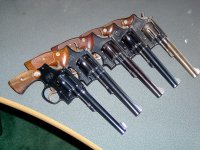Gunsmiths journals and references indicate strong connection between using WD-40 as a rust prevenative on unblued steel to erratic coloration after bluing. It's the silicone oil in WD-40 and not "silica" that is the culprit. Silica is the main ingredient in common beach sand. What is it doing in steel?
Silicon - MSN Encarta
Silicon, symbol Si, semimetallic element that is the second most common element on Earth, after oxygen. The atomic number of silicon is 14. Silicon is in group 14 (or IVa) of the periodic table (see Periodic Law). It was first isolated from its compounds in 1823 by the Swedish chemist Baron Jöns Jakob Berzelius. The element’s name comes from the Latin word for flint, a mineral that contains silicon.
Silicon is prepared as a brown amorphous powder or as gray-black crystals. It is obtained by heating silica, or silicon dioxide (SiO2), with a reducing agent, such as carbon or magnesium,
Silicon is used in the steel industry as a constituent of silicon-steel alloys. In steelmaking, molten steel is deoxidized by the addition of small amounts of silicon; ordinary steel contains less than 0.03 percent of silicon. Silicon steel, which contains from 2.5 to 4 percent silicon, is used in making the cores of electrical transformers because the alloy exhibits low hysteresis (see Magnetism). A steel alloy, known as duriron, containing about 15 percent silicon, is hard, brittle, and resistant to corrosion; duriron is used in industrial equipment that comes in contact with corrosive chemicals. Silicon is also used as an alloy in copper, brass, and bronze.
http://www.azom.com/Details.asp?ArticleID=1114
Most silicon is produced as a ferroalloy either ferrosilicon or silicon manganese, which is used exclusively in steel making. Silicon, as ferroalloy, is the most important deoxidiser in steel making. Semiconductor silicon is made mostly by reacting powdered crude metal with a gaseous mixture of hydrogen and hydrogen chloride in a fluidised bed. The main product SiHCl3 is fractionally distilled then reduced by hydrogen and is then deposited on a pre silicon filament, which is heated to about 1150°C. Further purification may be done by zone refining if required. Dopants are generally added subsequent to crystal growth.
John,
Respectfully, I hope this answers your question.
Patrick





